So many historical buildings were destroyed across London in the last war, however few have been reconstructed with such care, and continue to fulfill their original function as the subject of this week’s post.
A quick look at the following photo and it is another bomb site, however the white monument on the right of the photo confirms exactly where this is, the site of Chelsea Old Church, at the junction of Old Church Street and Cheyne Walk. When my father took the photo, very little of the church remained apart from the chapel on the right. The main body of the church along with the tower had been completely destroyed.
The same location today, with the reconstructed church. The monument and buildings to the right confirm the location.
And to confirm how accurately the church was reconstructed, the following photo shows the pre-war church.
In 1957 a booklet was published to raise money for the rebuilding fund. Titled “Chelsea Old Church, 1941 – 1950” it tells the story of the destruction of the church and the battle to rebuild.
The booklet starts with a paragraph summing up the night on which the church was destroyed:
“On the night of the 16th-17th April 1941, four hundred and fifty German bombers attacked south and central London for nearly eight hours. Civilian casualties were over one thousand killed and two thousand seriously injured, and among the buildings hit were eighteen hospitals and thirteen churches, one of which was Chelsea Old Church.”
Chelsea was heavily bombed that night with a total of five parachute mines, a range of high explosive bombs and hundreds of incendiary bombs. Parachute mines, or landmines were really the same mines as used at sea. They were dropped by parachute and detonated either by vibration or magnetism making them a problem on the ground until they could be safely dealt with.
April 16th had been a fine spring day, much like the day I visited the church, with the sun shining all day long.
The air raid sirens sounded at five past nine in the evening and the residents of Chelsea either headed towards air raid shelters or stayed in their homes and the fire watchers took up their positions ready to deal with any fires caused by incendiaries and to try and deal with any casualties of bombing.
Parachute flares were the first signs of the attack, dropping over the south east of Chelsea and over the Lots Road Power Station. The raid then intensified and the booklet takes up the story:
“By one in the morning about forty trapped casualties had been reported at the Royal Hospital Infirmary. A wardens’ post nearby had dealt with more than that number of walking cases and homeless persons. The Post Warden was conducting his senior officer, the District Warden, on a tour of the area, and they were returning from watching incendiary bombs rattling down on the warehouse roofs across the river when they saw six members of the Old Church Fire Party leave the shadow of the tower and walk away from it along Cheyne Walk towards Danvers Street.
The Post Warden had returned to Cook’s Ground School and was just lowering himself into a chair to make an entry in the Log Book when two heavy explosions occurred close at hand. The time was twenty past one. Everything in the room jumped, dust was shaken down, the noise of breaking glass and splintering woodwork came from elsewhere in the building. Leaving the telephonist in charge of the Post, the Post Warden dispatched all available wardens to investigate and went out himself. The District Warden joined him in the corridor. His windows had been blown in on top of him as he sat in his office, but he escaped injury. As they turned the corner from Gleve Place into Upper Cheyne Row light came from some of the houses; windows and window frames complete with blackout had been sucked out into the road or pushed into the room. Tiles, broken slates, lath and plaster, bits of wood and glass littered the roadway; but this was only the minor damage. Justice Walk was blocked halfway in from Lawrence Street and it was evident that the center of the damage was somewhere on the other side of it. As they ran round the corner into Cheyne Walk they were brought down by a length of garden railing. They saw flames leaping up in a thinning dust haze. Near Danvers Street in a shallow crater in the road a gas main was on fire. And then it came to them both: “The Old Church has gone!” There was a jagged stump of brickwork and projecting timbers silhouetted where the eye had expected the massive square tower.”
The account in the booklet then explains what had happened to cause such destruction:
“About the time the sirens sounded the “Alert”, Mallett and the others on duty had gone up to the top of the church tower, the first time they had been up there, he said. They stayed up there for a time watching the flares and then went down to the embankment. Later on they went back to the room on the first floor of Petyt House (just behind the church) for a cup of tea. After that they were in and out all the time. About one o’clock they went along Cheyne Walk towards Danvers Street and some of them were talking to one of the fire party on duty at the cafe on the corner there. The ack-ack fire had been very heavy and there was a lot of shell casing lying about.
He had picked up a nose cap which had fallen outside the house with the copper panels on the gates (75 Cheyne Walk). He remembered saying to himself; ‘This is made of phosphorous bronze, expensive stuff to chuck about like this’, and then he heard something fall on the road beside him. It landed with a thump, not very loud, ‘like a fifty pound weight falling on soft ground’. It was not an alarming noise, and he looked round casually to see what it was. Actually it must have been painted dark green, with the sea green parachute collapsing beside it. Mallett described it as a ‘big thing about seven feet long and as big as you could get your arms round.’
He shouted a warning to the others and started running. They probably saw it first for they were ahead of him and had turned into Old Church Street when a second mine struck and exploded between Petyt House and the Church. the explosion detonated the one which had landed unexploded beside Mallett. How he was not killed, blown to fragments like Michael Hodge and the others caught in the open, can only be guessed at. He said he was running too fast to turn the corner and follow the others up Church Street, and he was kneeling beside the fire alarm post on the corner of the street when the explosion took place. As he was on the far side of the tower and probably below the level of the church yard wall he was protected from the direct blast of the first explosion. There was in fact a fraction of a second’s interval between the two. It may be that the debris of the tower collapsed beside him into the roadway in time to divert the blast of the other mine lying not more than seventy-five yards away.”
The tower and the majority of the church had been complete destroyed. Only the More Chapel at the far end of the church from the tower remained (as can be seen in my father’s photo).
Map of the area in 1940 showing the church just above Carlyle Pier on the river with the street names, Old Church Street, Danvers Street, Lawrence Street, Cheyne Walk mentioned above.
The following plaque in the entrance to the church records the names of the fire watchers who were killed when the church was bombed.
Whilst the plaque records their names, the booklet provides some background to help us understand more about the people who died protecting the church:
“There was a leader appointed for each night in the week. Normally Wednesday’s leader was Mr Bottley of Gregory Bottley & Co. Mineralogists, 30 Old Church Street and Mrs Bottley made one of the party, but they had gone away the week before on a three weeks trip to North Wales to obtain geological specimens and their places on the rota were taken by their manager, Mr Fred Winter and optical lens maker Mr. Sidney Sims. Both men had been with the firm since leaving school and were highly regarded. Sims was engaged to be married, Winter was married with two children. With Mallett, Winter and Sims on duty that Wednesday were Mrs. Greene, Michael Hodge and Mr. Franklin. The later was a carpenter employed by the Westminster Carriage Company, 48 Old Church Street, and was not strictly speaking a member of the Fire Party but had attached himself to them for the company and they included his premises in their patrols. Michael Hodge was aged seventeen and very tall for his age. He was waiting to go up to Cambridge but talking of enlisting in the Black Watch. He was staying at the Grosvenor Hotel with his parents and used to come down to Chelsea on Wednesday evening by taxi. Yvonne Greene of 34 Old Church Street, a Canadian and newly married to a Canadian army officer, was a part-time Auxiliary Fire Service driver.”
With the church destroyed, the challenge was now to protect the church site and plan for rebuilding. Anything that could be recovered from the site was quickly recovered and stored, however the site attracted problems during the years after the bombing:
“During the next two years there were no major engagements, though it was necessary to carry on a constant warfare against children who used the site as a playground, scribbling undesirable remarks on the stones and carrying off wood and bricks for their own purposes; and against adults, whom less excusably, stole lead to sell and wood to burn. It was Mr. Stewart Jones who took the initiative by getting the site fenced, and organised a concert to pay for it.”
The challenge for the church was getting approval and the funding needed to rebuild the church. The amount of damage across London meant that both funding and the labor and materials needed were in short supply during, and in the years after the war. There was no automatic assumption that Chelsea Old Church would be rebuilt.
Approval for reconstruction and funding was subject to Diocesan authority and expenditure required the consent of the Diocesan fund. A Diocesan Reconstruction Measure of 1941 placed the church on a list of bombed churches that would not be rebuilt within five years from the end of the war and there was doubt whether the church would ever be rebuilt.
In March 1945 proposals from the Diocesan Reorganization Committee recommended limited reconstruction of the church with just the More Chapel being retained to house the monuments recovered from the church. The concern was that the remains of the church would be little more than a museum for the recovered monuments. A hard-fought campaign was needed over the following years to convince the Diocesan Reorganisation Committee that the full church should be rebuilt with permission and funding to build to the same design as the destroyed church. Fund raising took place and approval was finally given with the More Chapel reopened for services in 1950 and the whole church reconsecrated in May 1958.
The history of Chelsea Old Church requires a dedicated post to do justice to the church, however the following is a brief walk round the church.
Looking across the church to the More Chapel, the Jervoise arch and the memorial to Lady Jane Cheyne:
The church is the only one in London with any chained books. In a case within the church are five chained books, presented to the church by the Lord of the Manor, Sir Hans Sloane. The books consist of a Bible from 1717, first and third editions of Foxe’s Book of Martyrs from 1684, a 1723 book of Common Prayer and a 1683 volume of Homilies.
The remains of the tomb from 1555 of Lady Jane Guildford, Duchess of Northumberland.
The inscription reads:
HERE LYETH Y RIGHT NOBLE AND EXELLENT PRYNCES LADY JANE GVYLDEFORD LATE DVCHES OF NORTHVBERLAND DAUGHTER AND SOLE HEYRE VNTO Y RIGHT HONORABLE S EDWARD GVYLDEFORD KNIGHT LORD WARDEYN OF Y FYVE PORTES Y WHICH S EDWARD WAS SONNE TO Y RIGHT HONORABLE S RICHARD GVYLDEFORD SOMETYMES KNIGHT AND COMPANION OF Y MOST NOBLE ORDERE OF Y GARTOR AND THE SAID DVCHES WAS WYFE TO THE RIGHT HIGH AND MIGHTY PRINCE JOHN DVDLEY LATE DVKE OF NORTHVBERLAND BY WHOM SHE HAD YSSEW XIII CHILDREN THAT IS TO WETE VIII SONNES AND V DAWGHTERS AND AFTER SHE HAD LYVED YERES XLVI SHE DEPARTED THIS TRANSITORY WORLD AT HER MANER OF CHELSEY XXII DAY OF JANVARY IN Y SECOND YERE OF Y REIGNE OF OWR SOVEREYNE LADY QVEEN MARY THE FIRST AND IN A MDLV ON WHOSE SVLE IF SV HAVE M’CY
Standing in the church and thinking about even the recent history of the church, the words “this transitory world” are so very true for all those who have lived in, and traveled through London.
Although the bomb blast destroyed the majority of the church, the More Chapel was mainly intact and between the main body of the church and the More chapel, part of the original wooden construction of the church was exposed by the blast. The wooden “King Post” from the pre-Tudor construction of the building was not plastered over during rebuilding and has been left exposed.
Monuments and plaques from the 16th century onwards:
A view of the Sanctuary and on the right the memorial to Sir Thomas More.
Built by More for his first wife and intended by More also for him and his second wife after their deaths. The inscription, written by More describes his life and ends with a tribute to both his wives:
Sir Thomas More’s first loving wife lies here
For Alice and myself this tomb I rear
By Joan I had three daughters and one son
Before my prime and vig’rous strength was gone
To them such love was by Alice shown
In stepmothers, a virtue rarely known
The world believed the children were her own
Such is Alicia, such Joanna was
It’s hard to judge which was the happier choice
If piety or fate our prayers could grant
To join us three we should no blessings want
One grave shall hold us, yet in heaven we’ll live
And Death grants that which Life could never give
Another of the monuments from the original church, the triumphal arch commemorating Richard Jervoise:
The sundial on the south-facing tower of the church, remade in 1957 and identical to the original (see the pre-war photo at the top of this post to see the original sundial in the same position).
There are a number of monuments outside the church, including this water fountain built-in 1880 by the widow of George Sparkes of the East India Company:
The 1969 statue of Sir Thomas Moor.
Sir Thomas More’s association with the church began when he settled in Chelsea, the owner of a large estate close to the church. When he moved to Chelsea in 1520 he rebuilt one of the chapels and with his family, worshiped at the church when at his Chelsea residence.
Another memorial to a person with a close connection to Chelsea is the memorial to Sir Hans Sloan, who was also involved with the founding of the nearby Chelsea Physic Garden:
The fact that Old Chelsea Church is still here is a tribute to those who fought hard for the church to be re-built and to the same design as the pre-war church. It also reminds us of those who died trying to protect the area in which they lived and worked during the last war.
To finish, the following photo is an enlargement of a small section in front of the church from my father’s photo. I suspect this is an ice cream vendor cycling round the streets of Chelsea – very different to the busy road in front of the church today.
A church with a fascinating history and highly recommended for a visit, even if it is not a beautiful spring day in London.

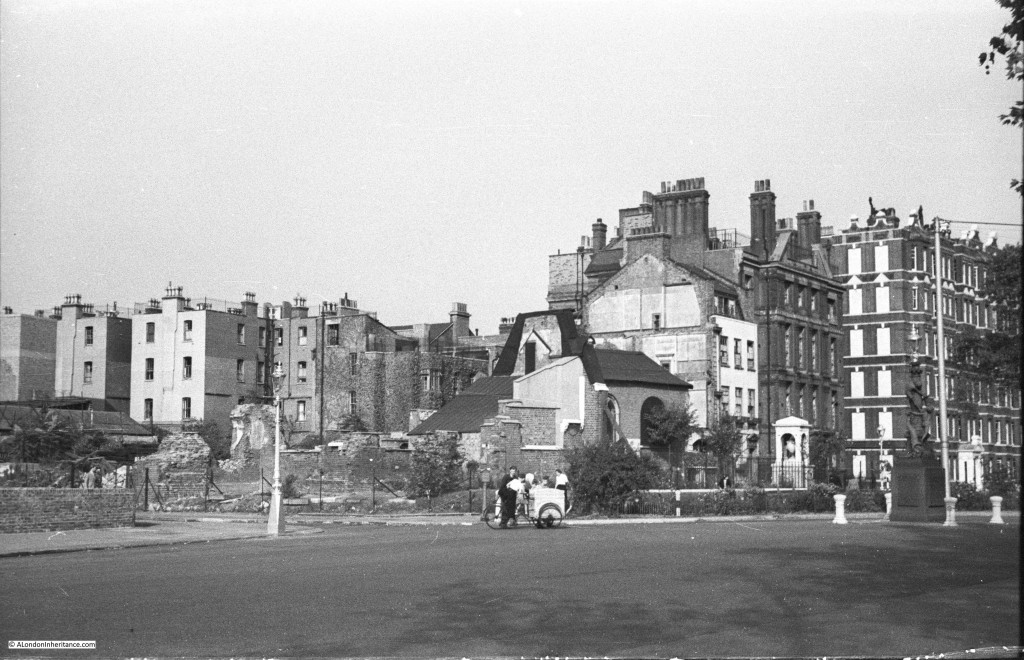
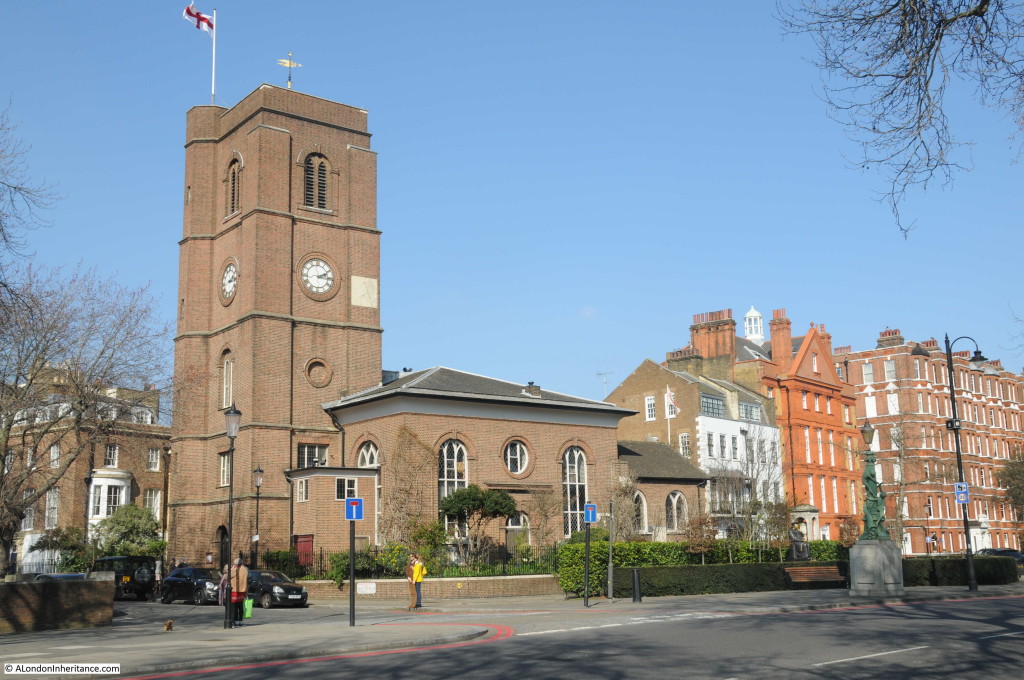

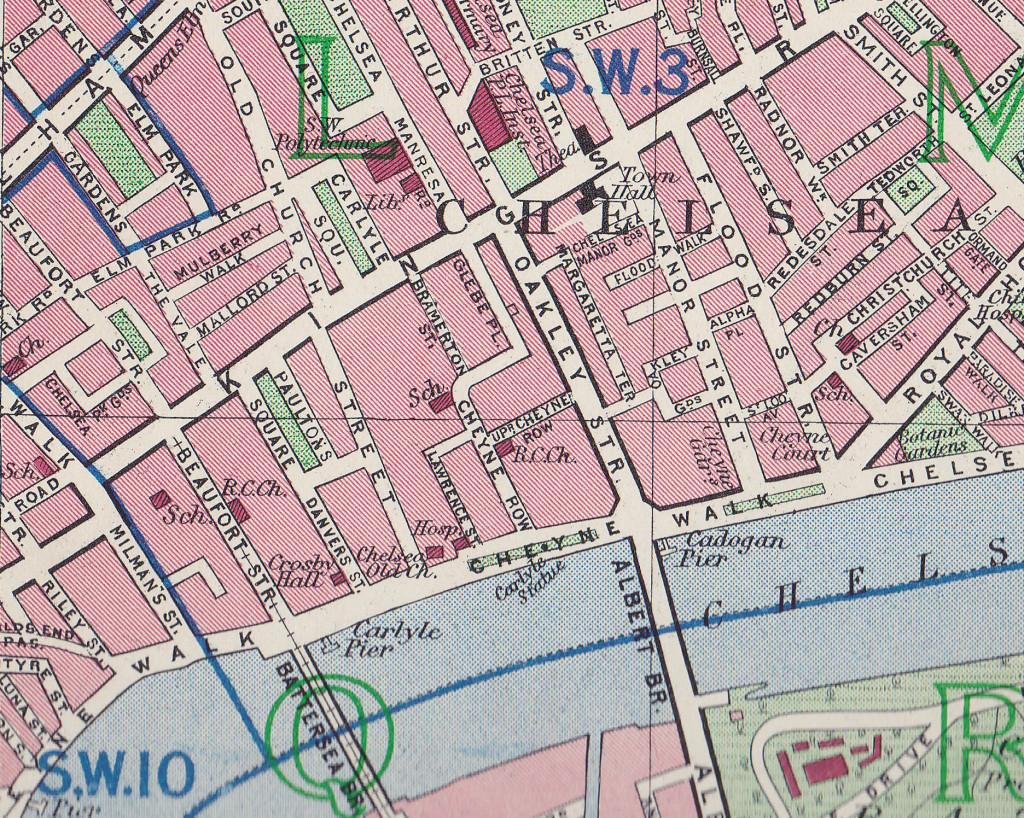
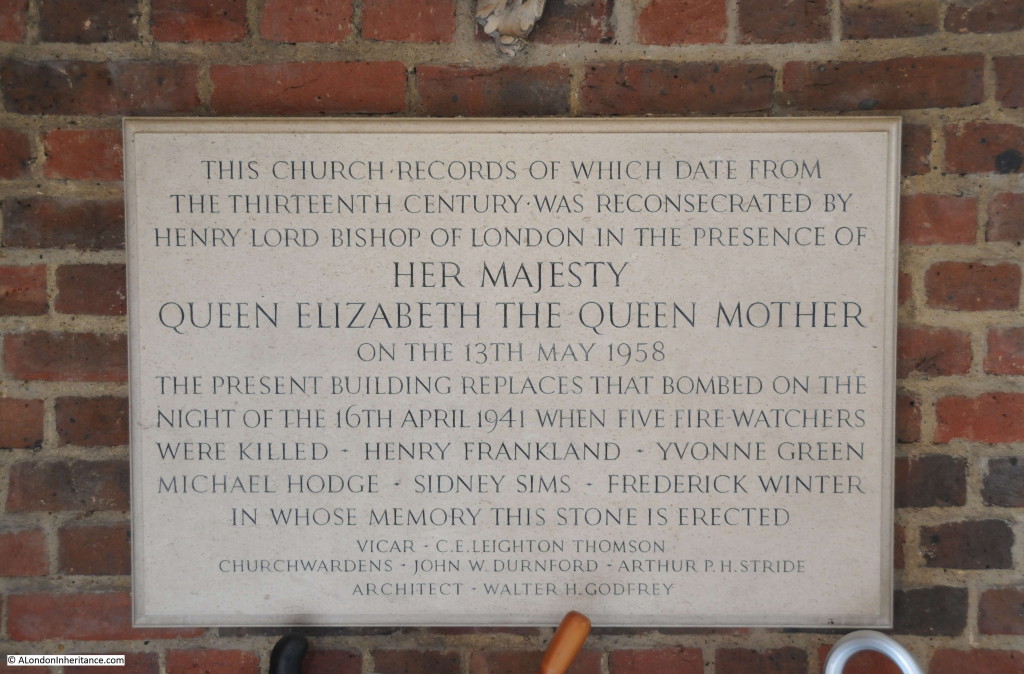
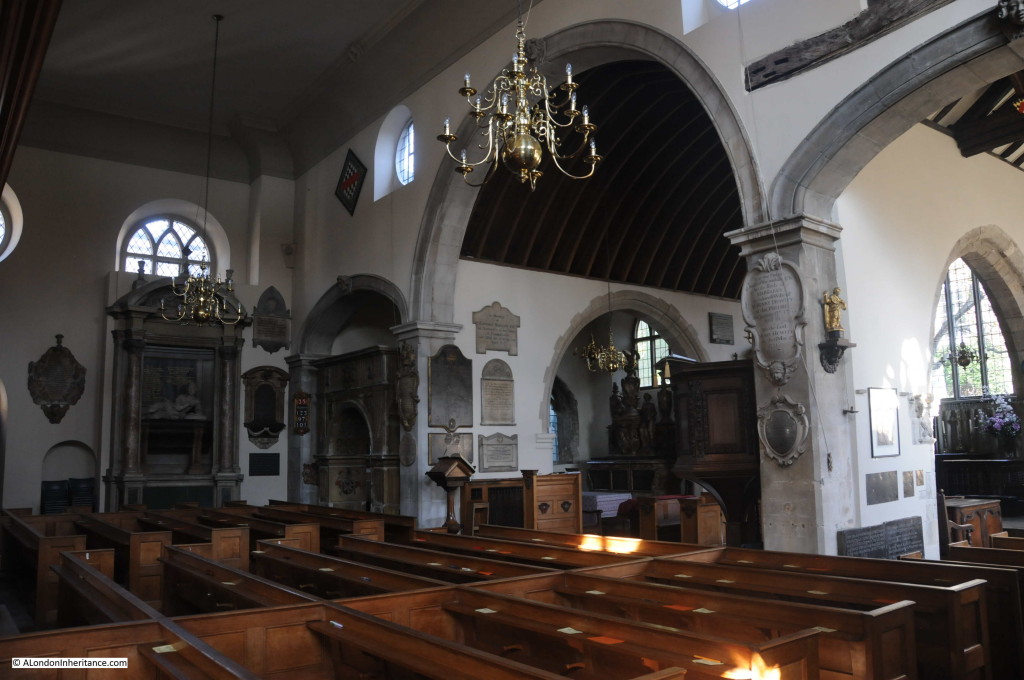

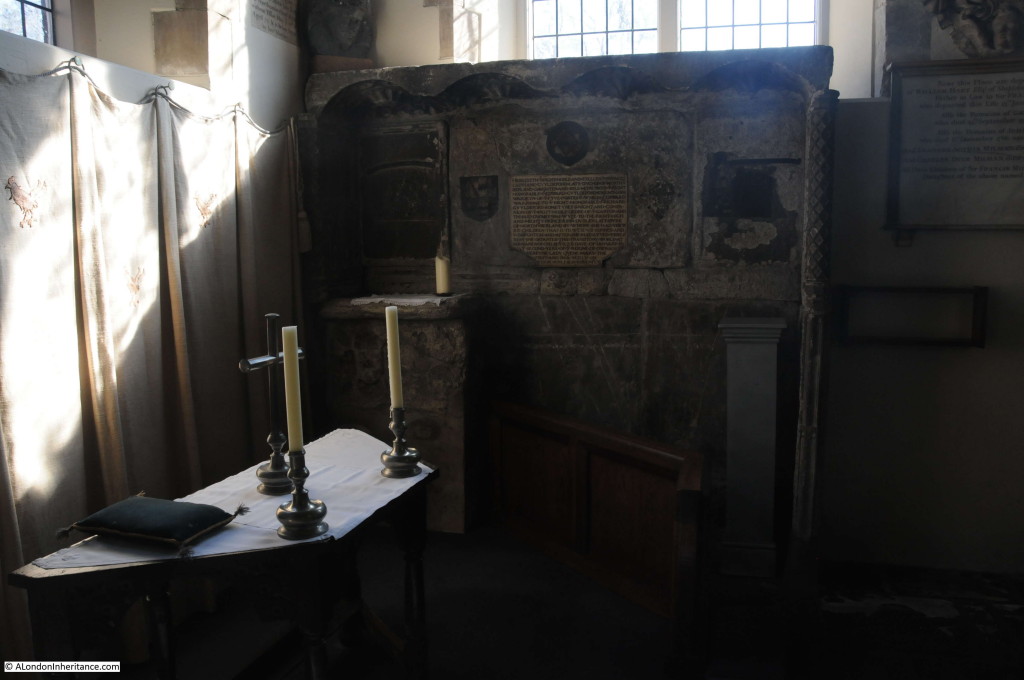
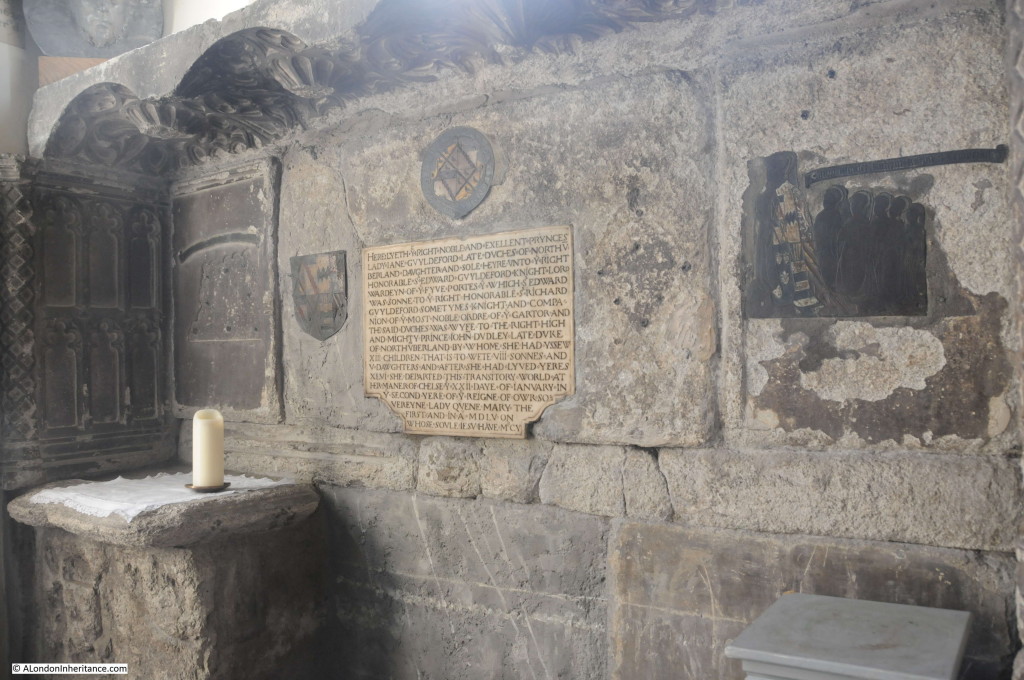


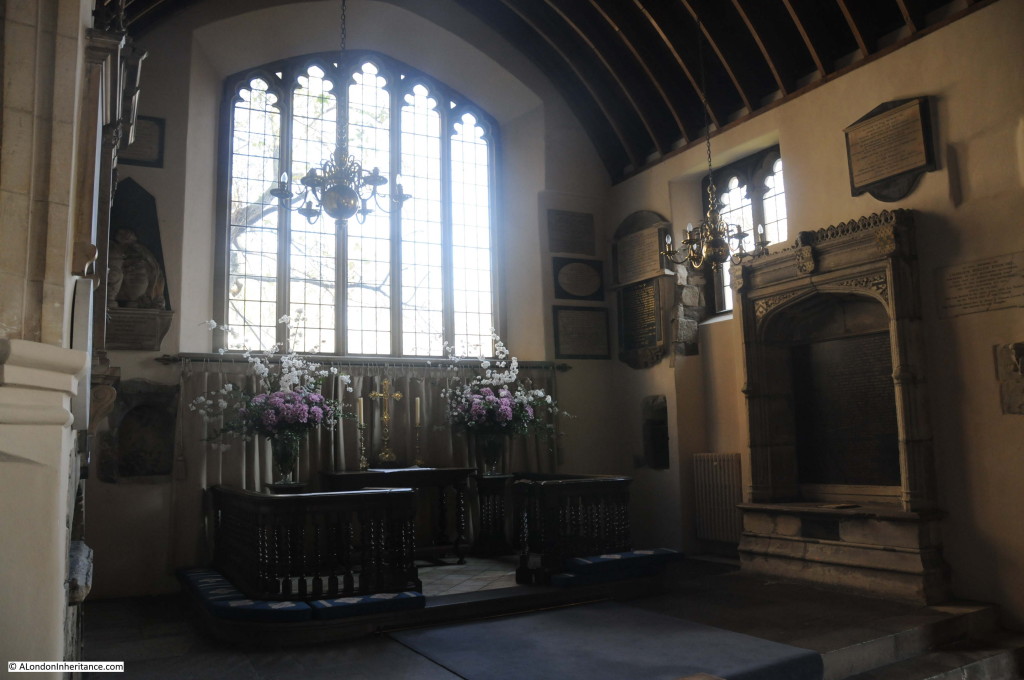



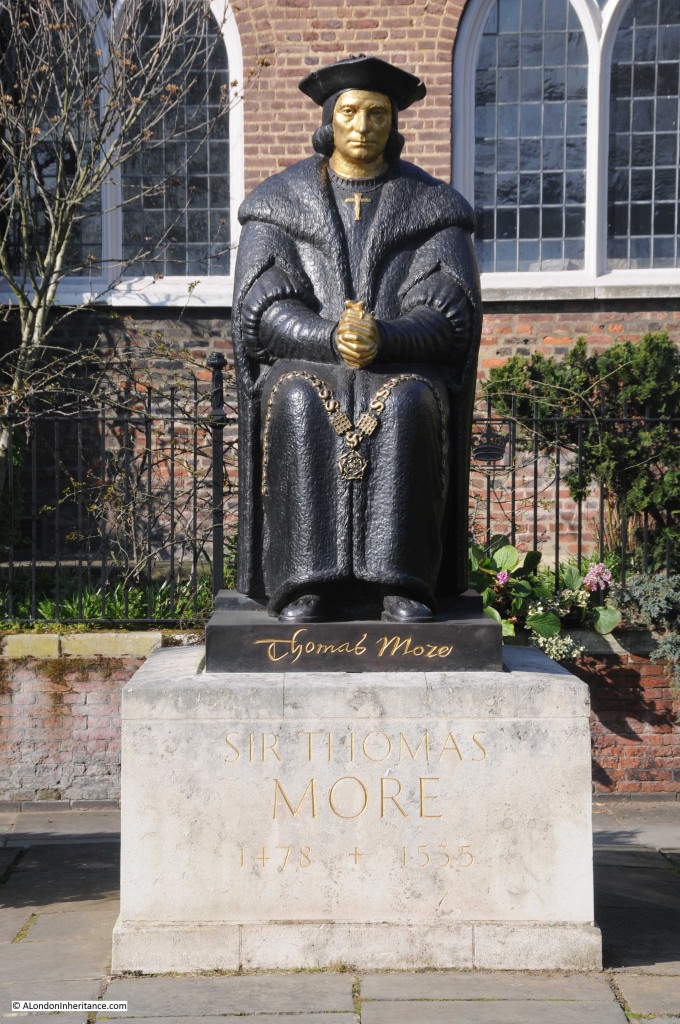
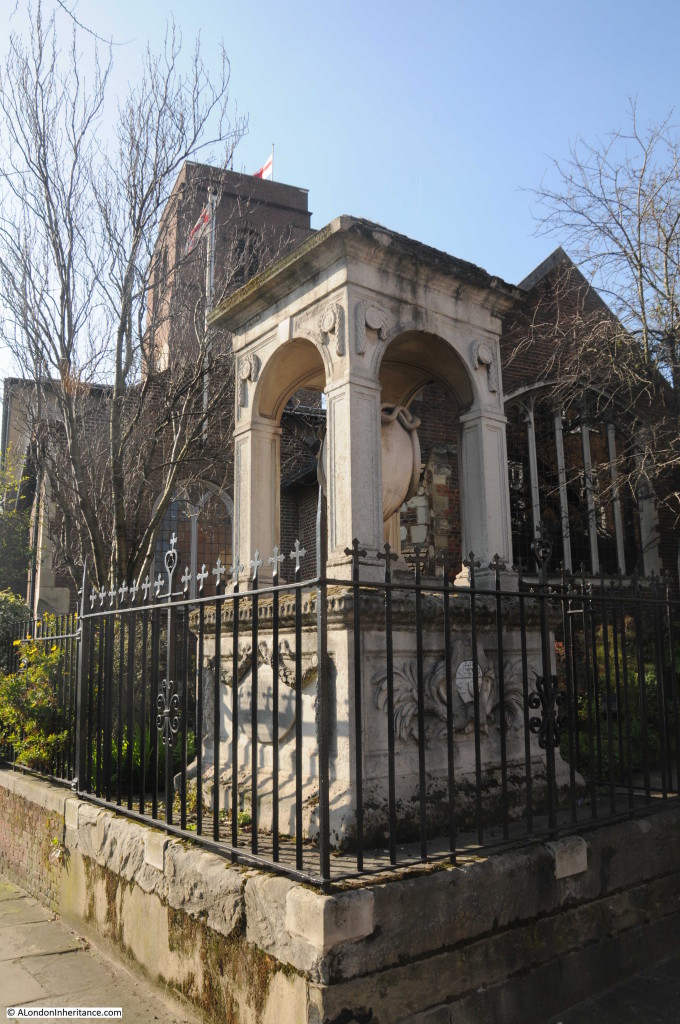
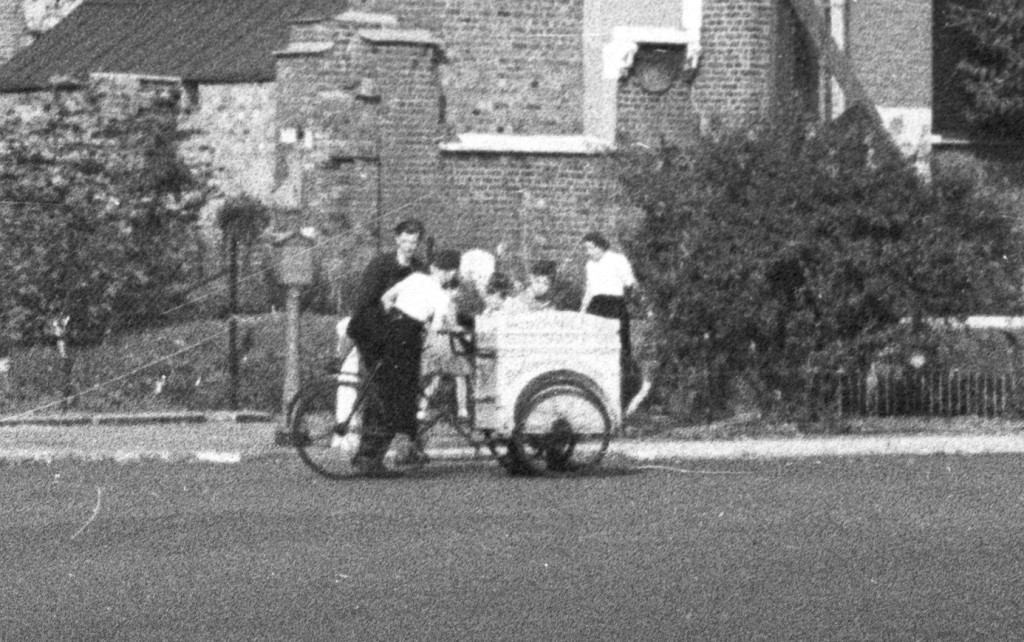
I started my school life at Cook’s ground in 1939. I entered through the right hand gate on Old Church Street that had a overhead engraved stone sign saying “Girls and Infants”. The left gate’s said “Boys”. I didn’t have far to walk because we lived at Rectory Chambers almost next door. In front of our house was McCauley’s grocery. He had two girls and I went to school with them. Between our house and the school was Roma’s cafe, Rosemary was my mother’s best friend. In front was the “Pig’s Ear”. Wooden beer barrels were off loaded from horse drawn wagons and slid into the the pubs cellar through a trap door in the pavement. Coal was also delivered to all the houses by horse cart and unloaded through small iron “manholes” in the pavements. The were no cars parked on the streets. Trams ran down Beaufort St. from Kings Road to Clapham Juction. A fellow on a bicycle lite the gas street lights with a flame at the end of a pole. .
Then all of a sudden ALL the lights went out. My mother got a summons because a light showed through the tiny bathroom window! Like all the other windows it should have been covered with black cloth.
The year after I started school we were labeled and posted by train to Cornwall. I returned home a year later because I had contracted diphtheria. The whole area at the end of the street was now a pile of rubble and a part of the church left standing was boarded up so we could’t get in, though we tried. There were still some of my friends around and we used the bricks to make dugouts and play “war” games throwing rocks at each others trenches. I was once knocked out and awoke in a neighbor’s kitchen while the lady bathed the back of my head. I have a photo of me on the rubble with my baby brother and mother nearby. It was taken by my father before he left for Africa. A neighbor named Bill Mallett became my best friend. He drove a lorry which he had parked in next to the damaged area in front of his house. He told me what had happened while I was away. He helped my mother repair our front windows. She had tomatoes planted in flower boxes on the roof. Paulton’s Square had “victory” gardens planted around the half buried shelters there. All the railings had been removed. I hated to go down after the air raid siren sounded because they smelt so bad. The wardens allowed me to site at the door with them and watch the planes until the noise got too loud. After the “all clear” my friends and I ran through the streets looking for bombs and shrapnel. One of us found a whole incendiary so he became our leader. He took it home for his collection and never did tell his parents! I found a small bomb and we tried to get set it off by repeatedly throwing it in our “war zone”. Finally it broke apart and it was filled with a yellow putty. Notices were pasted all around with photos of “booby” traps that were dropped by the Germans. They looked like toys but we never found one! I could have been one of the kids by the ice-cream cart shown above or at least they were my some of my friends.
I left Kingsley (Cook’s ground) for the last time through the left gate in 1948, Dr. George Walsh was head master. My girlfriend’s name was Sylvia Ashworth.
Paul, thanks for the comment, really interesting and very similiar to my father’s story. He grew up in Camden during the war and had exactly the same stories of hunting for shrapnel, playing in the ruins of bomb sites and he also had an incendiary. He was evacuated but came back after a couple of weeks so spent virtually all of the period in London. Lovely to have a photo of you on the old bomb site. Do you have a copy of the book about the wartime destruction of the church and the battle to rebuild. It tells of the battles the church had with local children to stop them playing on the ruins etc.
Thanks again for the story of your time in Chelsea. Regards, David
I have just found the marriage licence for my great-great-grandparents in 1823, saying they were to be married at St. Luke’s, Chelsea. That must have been in the old church. I was fascinated to read your story of the church’s destruction and reconstruction. Those great-great grandparents moved to Canada, and my father, their great-grandson, served in the Canadian army during WWII, and may have been in London when the church was bombed!
St Luke’s church is in Sidney Street, Chelsea. The bombed Chelsea Old Church is at the bottom of Church Street and faces the river. St Luke’s was newly built when your ancestors were married.
Thank you for that information.
I have just read the above articles on Chelsea Old Church with great interest. I was bought up at 30 Paultons Square, living there from 1945 to 1958 with my parents Laurence and Duffey Scarfe, both artists. Their ashes are now in Chelsea Old Church. I remember going to Sunday School in part of the bombed out Church, and have 2 bricks in the newly built tower. Many of us helped this way. I also remember playing on the bomb sites, even though my parents told us not to! Even though I now live in Southampton, I often return to the Church, to lay flowers in memory of both my parents. One day I will once again be united with them, as I too want my ashes to be laid at Chelsea Old Church. I am now a Stone Mason and Conservator, and at present I am carving a Centenary Poppy Memorial for the Royal Hospital Chelsea, and am also an exhibitor at Chelsea Flower Show. I am so glad the Church is enjoyed by many today .
To Caroline.
I have just read your comment. If you read my rather long essay above you will know that we were close neighbors. Our last residence was at #1 so I walked by your house daily on the way to school. Did you go to Kingsley also? My parents were artist though my mother later became a writer and my father taught ceramics.
I now live a long way away on a farm in the sunny Canary Islands.
Cheers. Paul
My grandparents were married in St Lukes. My family lived in old church street. My grandfather built a garage there. During the war my grandfather was air raid patrol and I’ve got a chunk of wood from the old church and a wooden cross that was saved as the church burnt.
Dear Lorna,
Good to read your article about Chelsea Old Church, but was wondering what you did to the cross that was rescued. I hope it has been given back to the Church, as part of archives.
Caroline Dear.
Fascinating to read such a detailed account. I grew up (initially) in Glebe Place and remember being taken by my father to the Old Church during rebuilding to have my name inscribed on a brick as part of the fundraising effort. Although I admire the fidelity of the reconstruction, there’s always been something about the building that doesn’t ring true for me, and I find it still looks 1950s to the eye — which it shouldn’t, given it’s obviously an exact replacement. I wonder if the problem is the bricks, which I suspect betray their postwar manufacture in colour and texture, or just the crispness of outline which would have softened and weathered more if it was the original. Mind you, this may just be my imagination and not bother anyone else!
Dear Don,
After reading your article about the new brickwork for Chelsea Old Church, the older ones would have been very much affected by the pollution in London, especially from the two power stations nearby! I remember everything black for years, until the big clean-up took place.
Another reason for the diiference could possibly be the number of missing memorials seen on the old photo, and nothing on the new brickwork.
It’s certainly good to know that our signed bricks went into the reconstruction of this special Old Church.
Caroline — Yes, I also remember the grime that covered everything, and of course it’s very visible in films shot on London locations in the late 40s/early 50s such as “The Lavender Hill Mob”. (For a contrast, see the rather fun 1969 Diana Rigg/Oliver Reed caper “The Assassination Bureau”, which features the Royal Courts of Justice sparkling after their then very recent clean and possibly looking better than when built.) You’re probably right about the smoky patina of the pre-war Old Church and without colour pics it’s impossible to see if the bricks were markedly different from their postwar replacements. Perhaps any builder or stonemason reading this could help?!
Don, I am now a Stonemason, strongly influenced by the London buildings! Having been on many sites (Westminster Abbey, St Paul’s, Wellington Arch, Waterloo Station, V&A, British Museum, St George’s Bloomsbury, and the Royal Courts of Justice ) – all using Portland Stone, their decay was very evident. Unfortunately cleaning in some cases has made the once ‘white’ stone go a tobacco colour after a short time, pulling even more dirt out… It is always interesting to see pre-cleaned London in the old films, before being swamped with modern glass buildings. Perhaps Conservation firms could help re bricks?
Caroline Dear.
Has anyone got any photos of 6B Old Church Street where I used to live?
Thank you
Nicky Strouts
Bill Mallet was my step fathers Uncle and lived at 27 Old Church Street. My step father also lived there some years later after the war when born. Every year for many years into my teens the Mallets would have a family get together in the church. It would be a huge gathering. I believe this went on into the early 80’s.
I am looking for Mark Brown who lived with his mom and dad at 48 Old Church Street – Inner Court, I do not remember the flat#, I lost touch with him in early 80s, we were in our twenties at the time, I would like to search him out, thanks